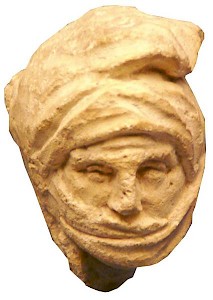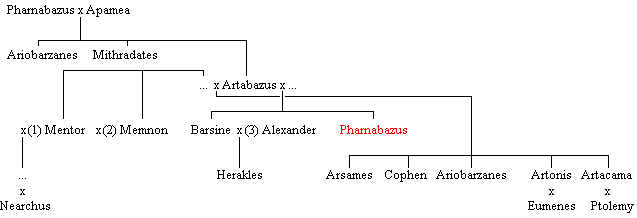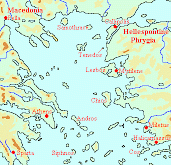Pharnabazus (3)
Pharnabazus (c.370-after 320): Persian nobleman, member of the Pharnacid house, one of the commanders in the war against Alexander the Great.

Pharnabazus was born between 370 and 365 as the first son of an important Persian nobleman Artabazus II. Like his ancestors, Artabazus served as satrap of Hellespontine Phrygia, a province of the Achaemenid empire in the northwest of modern Turkey. However, he was the last of the dynasty: he stood up against the Persian king Artaxerxes III Ochus in 358, was defeated and forced to live in exile.
In 353, the family arrived in Pella, the capital of Macedonia, which was ruled by king Philip II (360-336). With Artabazus, his wives and the young Pharnabazus was Barsine, Pharnabazus' sister. Also present was Memnon of Rhodes, a Greek mercenary who was closely related to the family: his sister was one of Artabazus' wives, and his brother Mentor was recently married to Barsine. The exiles met the young crown prince Alexander and may have met the famous philosopher and biologist Aristotle of Stagira, who arrived in Pella a few months before they were recalled, in 343.
In the nine years following his return, Pharnabazus gained military experience in the company of his uncle Memnon, who had become his brother-in-law, because Barsine had married him after the death of Mentor in 340. When Memnon was appointed as commander of the Persian navy in the Aegean sea in 334, Pharnabazus joined him.
 Alexander of Macedonia had invaded the Achaemenid empire in May 334 and had occupied the Greek towns in western Turkey. Memnon decided to defend Halicarnassus, the capital of Caria (modern Bodrum): Alexander could never move to the east as long as this harbor town held out (the garrison of Halicarnassus would attack his rear), so he was forced to besiege the town. However, the walls of Halicarnassus were exceptionally strong, and Alexander had no navy; the Persians would be able to inflict severe losses on the Macedonians and could sail away whenever they started to feel uncomfortable about their own losses.
Alexander of Macedonia had invaded the Achaemenid empire in May 334 and had occupied the Greek towns in western Turkey. Memnon decided to defend Halicarnassus, the capital of Caria (modern Bodrum): Alexander could never move to the east as long as this harbor town held out (the garrison of Halicarnassus would attack his rear), so he was forced to besiege the town. However, the walls of Halicarnassus were exceptionally strong, and Alexander had no navy; the Persians would be able to inflict severe losses on the Macedonians and could sail away whenever they started to feel uncomfortable about their own losses.
Even though the town fell in the first months of 333, the siege of Halicarnassus was in a sense a Persian victory: after the siege, Alexander needed reinforcements, and it gave the Persians -shattered after the battle at the Granicus river - the opportunity to regroup.
After the evacuation of Halicarnassus, Memnon started to reconquer the Aegean islands: he and Pharnabazus commanded 300 warships -being manned by Phoenicians, Egyptians and Cypriots-, thousands of Greek mercenaries and an abundance of silver and gold. Their aim was to seize the towns near the Hellespont and cut off Alexander's line of supply, and then bring the war to Macedonia. Moreover, they contacted the Spartan king Agis III, who was willing to organize an expedition to liberate Greece from the Macedonian hegemony. Alexander's expedition was now in great danger, and he was unable to march eastward, because he could not run the risk of loosing Greece.
Cos, Chios and Lesbos were the first targets of this energetic offensive. Unfortunately, much time was wasted during the siege of Mytilene, the capital of Lesbos; nonetheless, the results of this campaign were impressive, and Alexander had to order the Macedonians at home to build a fleet.

During the siege of Mytilene, Memnon died (of natural causes). Pharnabazus was the new commander and soon proved what he was worth: he took Mytilene and continued to the north, where he captured the little island Tenedos. It controls the entrance of the Hellespont; Pharnabazus could cut off the grain supply of Athens, had he wanted to.
During the summer, Pharnabazus fortified a fortress near Halicarnassus, which made it impossible for the Macedonians to use the harbor they had won after so many losses. The islands Samothrace, Siphnos and Andros were conquered, Miletus was occupied and Pharnabazus' navy seized every Greek ship in the Aegean. He even established a base at Callipolis, a town within the Hellespont. These acts were all the more impressive because Pharnabazus had been ordered to sent a large part of his mercenaries to the east, where the Persian king Darius III Codomannus hoped to defeat the army of Alexander.
Unfortunately, Darius lost the battle of Issus (November 333). This bad news reached Pharnabazus at Siphnos, where he was conducting talks with the Spartan king Agis about his insurrection against the Macedonians. The talks came to nothing (although Agis was to revolt two years later).
After Issus, Pharnabazus was in the defensive. He had to suppress a rising on Chios, and a Persian flotilla was defeated near Callipolis by a Macedonian-Athenian fleet. Worse was to come when in the Spring of 332, Alexander started to besiege Tyre. Eighty Phoenician and 120 Cypriot captains decided to go home. Pharnabazus' navy disintegrated, and what was left of it was defeated off Chios.
Pharnabazus was taken captive and sent to Alexander in Phoenicia, but managed to escape and reached Cos. There, this brave defender of the Persian cause disappears from our sources for a decade. We may assume, however, that he was with his father Artabazus in Hyrcania when he surrendered to Alexander in July 330. It is certain that Pharnabazus served as a cavalry commander in one of the Macedonian armies in 321.
The year of his death is unknown, but the later kings of Cappadocia would claim descend from the Pharnacids.